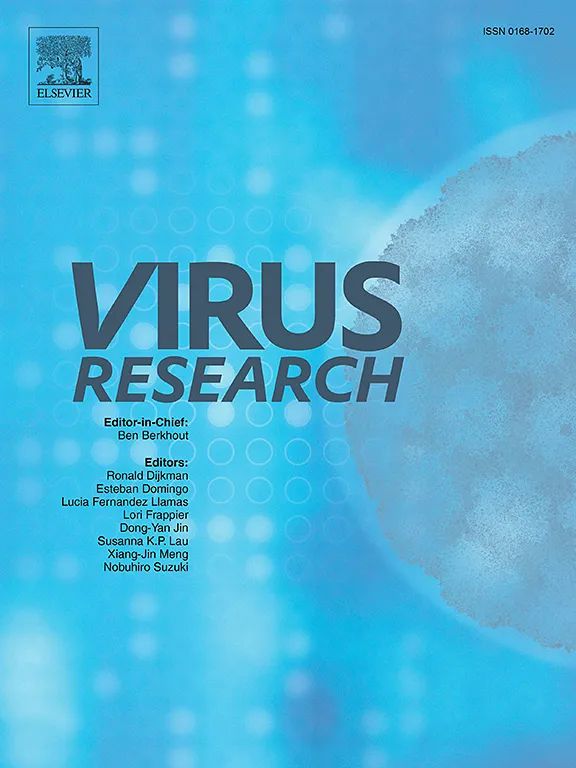溶解性噬菌体 vB_KpnP_23 的分离与特征描述:针对耐碳青霉烯类肺炎克雷伯氏菌的有望抗菌候选物
IF 2.5
4区 医学
Q3 VIROLOGY
引用次数: 0
摘要
耐碳青霉烯类肺炎克雷伯氏菌(CRKP)对全球健康的威胁因有效治疗手段有限而加剧。噬菌体是有望替代传统抗菌剂的药物。然而,目前的噬菌体数据库十分有限。因此,鉴定和描述新噬菌体可为治疗多重耐药细菌感染提供生物选择。在此,我们报告了从医院污水中分离出的新型溶菌噬菌体 vB_KpnP_23 的特征。这种噬菌体对产碳青霉烯酶的 CRKP 菌株具有很强的活性,其特点是头部呈二十面体,尾部可伸缩,基因组由 40,987 个碱基对组成,G+C 含量为 51%。它能够靶向裂解九种不同胶囊类型(K 型)的 CRKP,包括与临床相关的 ST11-K64,在各种环境条件下都表现出很高的杀菌效率和稳定性。最重要的是,vB_KpnP_23 缺乏毒力因子、抗菌药耐药性基因或 tRNA,符合治疗应用的关键标准。对噬菌体-抗生素组合的体外评估显示,vB_KpnP_23 与美罗培南、左氧氟沙星或阿米卡星之间具有显著的协同效应。这种协同作用可使最小抑菌浓度(MIC)降低 8 倍,这表明将这种噬菌体与上述抗生素结合起来进行综合治疗可大大提高药物疗效。这种方法不仅扩大了这些抗生素的临床应用范围,还在抗击抗生素耐药性方面取得了战略性进展。具体来说,它强调了噬菌体-抗生素组合作为治疗由 CRKP 引起的感染的有力工具的潜力,为减轻抗生素耐药性病原体对公共卫生的挑战提供了一条前景广阔的途径。本文章由计算机程序翻译,如有差异,请以英文原文为准。
Isolation and characterization of lytic bacteriophage vB_KpnP_23: A promising antimicrobial candidate against carbapenem-resistant Klebsiella pneumoniae
The global health threat posed by carbapenem-resistant Klebsiella pneumoniae (CRKP) is exacerbated by the limited availability of effective treatments. Bacteriophages are promising alternatives to conventional antimicrobial agents. However, current phage databases are limited. Thus, identifying and characterizing new phages could provide biological options for the treatment of multi-drug resistant bacterial infections. Here, we report the characterization of a novel lytic phage, vB_KpnP_23, isolated from hospital sewage. This phage exhibited potent activity against carbapenemase-producing CRKP strains and was characterised by an icosahedral head, a retractable tail, and a genome comprising 40,987 base pairs, with a G + C content of 51 %. Capable of targeting and lysing nine different capsule types (K-types) of CRKP, including the clinically relevant ST11-K64, it demonstrated both high bacteriolytic efficiency and stability in various environmental contexts. Crucially, vB_KpnP_23 lacks virulence factors, antimicrobial resistance genes, or tRNA, aligning with the key criteria for therapeutic application. In vitro evaluation of phage-antibiotic combinations revealed a significant synergistic effect between vB_KpnP_23 and meropenem, levofloxacin, or amikacin. This synergy could lead to an 8-fold reduction in the minimum inhibitory concentration (MIC), suggesting that integrated treatments combining this phage with the aforementioned antibiotics may substantially enhance drug effectiveness. This approach not only extends the clinical utility of these antibiotics but also presents a strategic advance in combating antibiotic resistance. Specifically, it underscores the potential of phage-antibiotic combinations as a powerful tool in the treatment of infections caused by CRKP, offering a promising avenue to mitigate the public health challenges of antibiotic-resistant pathogens.
求助全文
通过发布文献求助,成功后即可免费获取论文全文。
去求助
来源期刊

Virus research
医学-病毒学
CiteScore
9.50
自引率
2.00%
发文量
239
审稿时长
43 days
期刊介绍:
Virus Research provides a means of fast publication for original papers on fundamental research in virology. Contributions on new developments concerning virus structure, replication, pathogenesis and evolution are encouraged. These include reports describing virus morphology, the function and antigenic analysis of virus structural components, virus genome structure and expression, analysis on virus replication processes, virus evolution in connection with antiviral interventions, effects of viruses on their host cells, particularly on the immune system, and the pathogenesis of virus infections, including oncogene activation and transduction.
 求助内容:
求助内容: 应助结果提醒方式:
应助结果提醒方式:


